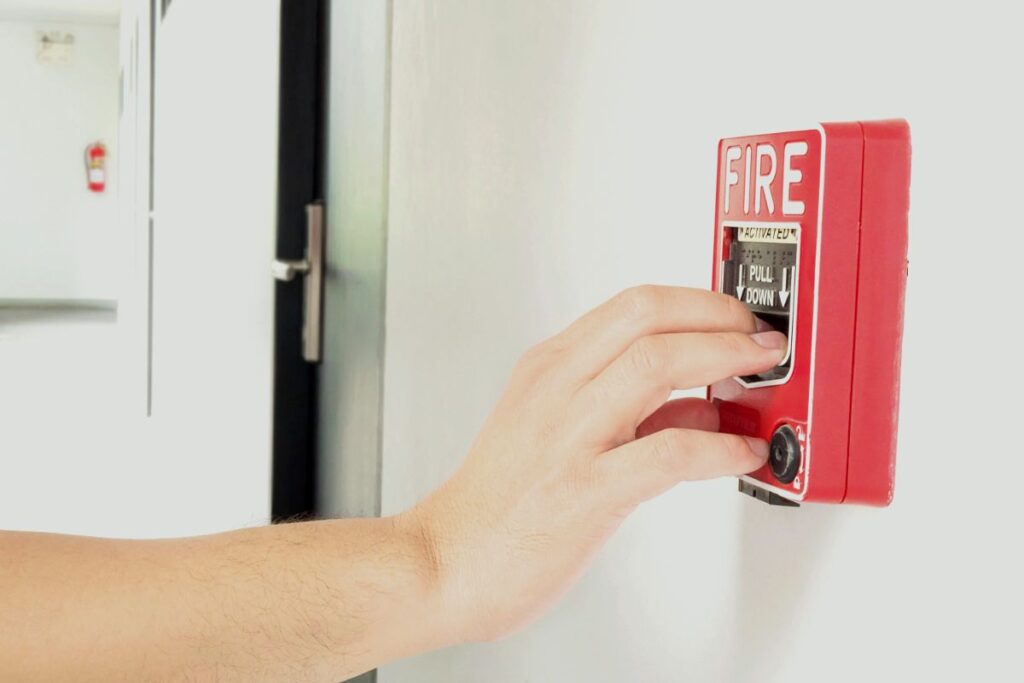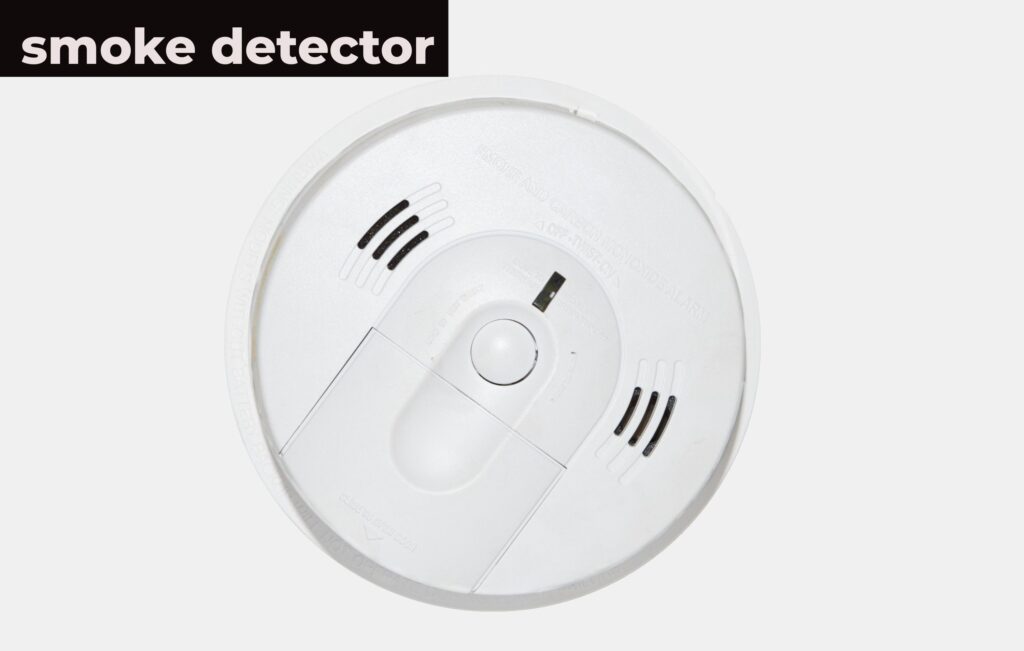- What is a smoke detector?
- Smoke detector types
- Aspirating smoke detectors
- Auto-aligning and optical beam smoke detectors
- Heat alarms
- Smoke detector installation and maintenance
- Why is my smoke detector beeping?
- How to change smoke detector battery?
- Materials
- Step One: Take Down the Detector
- Step Two: Replace the Battery
- Step Three: Test the Alarm
- Step Four: Place the Cover
What is a smoke detector?
An electronic smoke detector is a fire safety equipment that automatically detects the presence of smoke. Which is a major sign of a fire, and alerts those who live in the building.
As a component of a building’s main fire alarm system, commercial and industrial smoke detectors send a signal to a fire alarm control room. A smoke detection system is required for under regulations of every business
Smoke alarms, often known as household smoke detectors, emit a localized visual and/or auditory alert. They might be a single battery-operated device or a number of connected hardwired. (mains-powered) battery-operated devices. Both new construction and large renovations must have the latter installed.

Smoke detector types
Remote smoke detectors come in two major types: desorption (a physical process) and photodiode (visible). In order to provide the best protection against both fast-flaming and slow-smouldering fires. A dual sensor smoke alarm is advise.
There are other options for combination smoke and carbon monoxide alarms and visible smoke and heat alarms.
When smoke enters the detection chamber, a photoelectric detector detects a sudden variation of light, setting off the alarm.
Compared to ionization alarms, photoelectric smoke detectors react to fire in its early, smoldering state, before it ignites, on average, 15 to 50 minutes quicker. Near kitchens they can be installed . Some dual optical models are available.
Aspirating smoke detectors
As part of active fire prevention, there are also more and more aspirating smoke detectors (ASD) available on the market. These are more complex, extremely sensitive devices that offer early warning detection.
The way ASD systems operate is by using tiny, flexible tubing to suck air into each area. Then, in a continual procedure. The air is analyzed to detect the presence of tiny smoke particles. They can identify smoke before it is even apparent since they are not dependent on the movement of air in the environment.
When difficult circumstances such regions with strong airflow, condensation, or the need for extremely early detection are present. Aspiration systems are frequently utilized and recommended. such as communications and computer rooms.
Auto-aligning and optical beam smoke detectors
A laser-assisted infrared optical beam smoke detector, which self-aligns in less than a minute, is the newest kind of intelligent smoke detector. Large public and commercial areas with high ceilings, skylights, or condensation problems. Such theaters, retail centers, and sports arenas, are protected by them.
It is possible to install up to four detector sets per device with certain types.
By the way, some smoke detectors are really security equipment with concealed cameras instead of smoke detectors.
Heat alarms
Heat alarms are insensitive to smoke, but they can detect a fire-induced rise in temperature. Although they can be used in a dusty room, garage, or kitchen. They shouldn’t the only method used to detect fire.
Smoke detector installation and maintenance
An experienced electrician or installation specialist is require to install mains-powered alarms. Because they don’t require wire, domestic smoke alarms are more simpler to install; nevertheless, they still need to be properly installed, maintained, and routinely inspected.
The typical lifespan of a smoke detector is eight to ten years. Batteries should updated at least once a year and detectors should inspected at least once a week.
The lifespan of a hard-wired smoke detector is ten years.
Why is my smoke detector beeping?
A smoke detector beeps most commonly because its battery is low and needs to be replaced; this is a signal to change the battery to ensure the detector is functioning properly when needed.
Other reasons your smoke detector might be beeping include:
- Dust buildup: Dust accumulation on the sensor can trigger false alarms.
- Expired detector: Smoke detectors have a lifespan and may start beeping when nearing the end of their life.
- Placement issues: Placing the detector near a cooking area or where steam can reach it can cause false alarms.
- Humidity: High humidity levels can interfere with the sensor.
- Damaged sensor: Physical damage to the detector can cause malfunctioning.
- Loose connections: A poorly secured battery compartment could cause intermittent beeping.
- Insects: Pests entering the detector can disrupt its function.

What to do:
- Replace the battery: This is usually the first step to address a beeping smoke detector.
- Clean the detector: Regularly dust the smoke detector to remove debris.
- Check for damage: Inspect the detector for any visible damage.
- Consider replacement: If the detector is old or has been beeping frequently despite battery changes, it may be time to replace it.
How to change smoke detector battery?
Experts in fire safety advise changing your smoke detector’s batteries every six months or twice a year. If you forget, don’t worry; your smoke detector will alert you when new batteries are need by beeping obtrusively as the battery level drops.
A 9-volt battery is the most often used battery type in smoke detectors. More recent versions, meanwhile, can need two or three AA batteries. To prevent purchasing the incorrect kind. It’s crucial to consult the user manual or carefully inspect the expired battery before rushing to the store. To match it up, think about bringing one of the old batteries to the retailer.
Determining which smoke alarm is playing is the most difficult task. Replacing the battery will simply take a few minutes after you’ve identified the issue.
Materials
- Ladder
- Battery
- Screwdriver
Step One: Take Down the Detector
If necessary, place the ladder on a level, firm surface beneath the smoke detector and gently ascend. Next, decide if a screwdriver is necessary. Some smoke detector types require a screwdriver to unlock a plastic lock. Although the majority twist open. (you twist the detector counter-clockwise, or to the left, to remove it from the backplate that’s install on the ceiling).
Remove the smoke detector from the ceiling backplate after consulting. The user manual for your model to find the optimum opening technique.
Step Two: Replace the Battery
Once you’ve taken the detector down, locate the battery, remove it, and pop in a new identical one. Make sure the battery’s positive and negative ends have been correctly positioned before installing it. Otherwise, it won’t work, and you’ll have to take it down again.



Step Three: Test the Alarm
Make that the new batteries function properly before completing the smoke detector’s reinstallation. Every model of smoke detector has a test button. To activate, find this button and hold it down for a few seconds.. Warning: It might be really loud.
If the smoke detector beeps, you’re all set. If the sound doesn’t go off, try reconnecting the battery or using a different, new battery. additionally that still doesn’t work, your smoke detector may need replacing.
Step Four: Place the Cover
You can replace the smoke detector if the test passes without any issues. Screw it into the backplate or twist it to the right, depending on the type you own.
